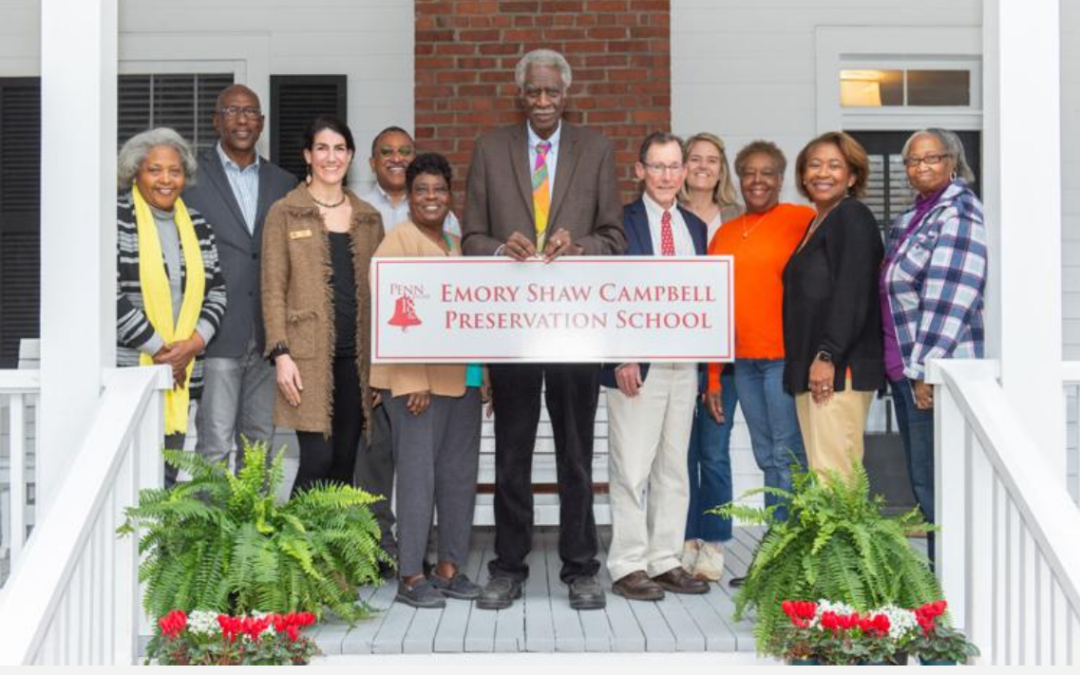SOUTH CAROLINA: Penn Center School Looks to Raise A New Generation of Activists
ST. HELENA ISLAND — Emory Campbell was uncharacteristically late and looking a bit harried as he entered Penn Center’s Hampton House on the first day of March.
Campbell was there, as were others, to plan the relaunch of the Penn School for Preservation, which operated for two years in the early 1990s. The new iteration of the school was to be officially named the Emory Shaw Campbell Preservation School in his honor that afternoon, which made Campbell’s late appearance all the more stressful.
Over lunch, Campbell recounted his 40-mile drive from his home on Hilton Head to the Penn Center campus on St. Helena Island. He was, he said, making good time along the newer, four-lane highways. As he hit the Sea Island Parkway closer to St. Helena, the roadway dropped down to a single lane in each direction. Traffic slowed for a bit.
“I thought, ‘That doggone CPO!’ ” Campbell said, and the room erupted with laughter.
It was an inside joke, but Campbell knew his audience.
New issues, new school
The CPO that Campbell cursed, albeit in jest, is more formally known as the St. Helena Island Cultural Protection Overlay. It is arguably the crowning achievement of the Penn School for Preservation. Campbell was integral in the creation and operation of that program, as were many in the room that morning.
Those who hadn’t been part of the program were still well aware of its achievements and the significance of the overlay.
Adopted by Beaufort County in 1999, the overlay was intended to preserve the Gullah culture of St. Helena Island by prohibiting certain types of development that were believed to be a threat — gated communities, golf course and resorts. If one were to wonder why St. Helena doesn’t look like it’s neighbor just a few miles to the south, Hilton Head Island, they wouldn’t need to look much further than the Cultural Protection Overlay.
In late 2022, an effort was launched to develop a golf resort on a 500-acre parcel on the north side of St. Helena Island, generally referred to as Pine Island. The Cultural Protection Overlay took front and center in the opposition to the plan. In any number of county meetings it was argued that the proposed development was prohibited by the overlay, and the county ultimately denied permission for the project.
The matter has moved to the courts, and mediation between the opposing parties is scheduled for April 19. If agreement is not reached in mediation, the legitimacy of the Cultural Protection Overlay could be challenged in court.
It’s this challenge that brings the story back to the Penn School for Preservation and the decision to relaunch the school now, nearly 30 years since it last operated.

Deloris Pringle, chair of the Penn Center Board of Trustees, leads the discussion on plans for the Emory Shaw Campbell Preservation School on the Penn Center campus March 1, 2024.
“The catalyst was this whole fight over Pine Island,” Deloris Pringle, board chair of the Penn Center, told The Post and Courier. “We realized that we need a new generation of preservationists coming along.”
Beginnings
Campbell was serving as the Penn Center’s executive director, a post he held from 1980 to 2002, when a couple of staff members from the Charleston-based Coastal Conservation League — Dana Beach, the league’s founder, and Nina Morais — came knocking on his door.
In their book “A Wholly Admirable Thing — Defending Nature and Community on the South Carolina Coast,” authors Virginia and Dana Beach explain that in the early 1990s the Coastal Conservation League concluded that the human landscape was inexorably tied to the natural landscape, and both needed protection. Development pressure on St. Helena brought them to Campbell, though the timing was less than ideal.
“I was overwhelmed,” Campbell explained. “It was a struggle to keep Penn Center open.”

The relaunched Penn School for Preservation was named for Emory Campbell, who served as executive director of the Penn Center from 1980 to 2002. Campbell was honored during the naming ceremony on March 1, 2024.
Despite his challenges, Campbell worked with the league, and the collaboration between Campbell, Morais and Beach gave rise to the Penn School for Preservation. A S.C. Department of Transportation project proved to be the spark for the school in much the same way that the Pine Island development motivated the school’s second iteration.
DOT had proposed expanding the two-lane Sea Island Parkway to five lanes through St. Helena Island, and a grassroots effort by island residents fought the project. Their efforts eventually proved successful, and the rural nature of the Sea Island Parkway remains, even if it does sometimes slow traffic a bit.
“That brought people together,” Campbell said. “Everywhere you looked people were protesting the highway widening, and that gave them the impetus for putting together the Cultural Protection Overlay. That issue really highlighted the reason for the school.”
The trio, along with others, took a year to develop the curriculum. In October 1993, the first class of 40 students started working their way through the program focused on community economic development, environmental stewardship and protection, and leadership development.

Dana Beach, founder of the Coastal Conservation League, discusses plans for the Emory Shaw Campbell Preservation School on the Penn Center campus March 1, 2024.
The school’s two objectives were to find economically viable alternatives to destructive forms of development and to provide sea island residents with the skills to be an influence in the local land planning process.
“Emory and Dana Beach worked together to come up with a strategy to help communities understand and navigate the land use process so they could speak up for themselves and their local communities,” said Faith Rivers James, executive director of the Coastal Conservation League.
The bar was set high, but the consequences of rampant land development on other sea islands were clear evidence of what was at stake — a loss of cultural identity for the people who lived on land that had been in their family for generations, also known as heirs’ property. The Gullah culture is a land-based culture, Campbell said.
“You live there,” he continued. “Your children live there. Your grandchildren live there. They learn the history of the land. They learn the importance of the land. The culture perpetuates itself based on the land.”
A new generation
As issues with the proposed development on Pine Island emerged, many of those leading the preservation effort were graduates of Penn’s preservation school, observed James. It was also apparent that those leaders were getting older. Pine Island brought the need for a new generation of preservationists into sharp relief. Nearly 30 years after the second and final Penn School for Preservation class graduated, it was time to relaunch the school.
“There’s a whole new generation you have to teach how to preserve, and teach how to teach others to preserve,” Campbell said. “We need new blood, and we have different issues.”
Robert Adams, Penn Center’s executive director, explained that the reason the first iteration operated for only two years was a simple one: Grant funding only lasted for two years, and grant funding would be necessary to get the new school off the ground.

Robert Adams, executive director of the Penn Center, discusses plans for the Emory Shaw Campbell Preservation School on the Penn Center campus March 1, 2024.
The Coastal Community Foundation, the largest community foundation in South Carolina, stepped in with a $650,000 Catalyst Grant to be disbursed over five years. The grant will be used to fund the development of the new curriculum and operate the school into 2028.
The school received another boost when the 2024 Historic Preservation State Grant Fund approved a $200,000 grant. Those funds will be used to restore Cedar Cottage on the Penn Center campus, which will be the home of the Emory Shaw Campbell Preservation School.
The new school will be built on the same three pillars as the original school: community economic development, environmental stewardship and protection, and leadership development.
There will be some differences in the operation. The grant funding focuses the program on Beaufort County. There will be a greater effort to recruit younger students, and a program for high school students is also planned.
What won’t change is the intent to build a cadre of people who can work together to shape the future of the county, Adams said.
“It’s about ensuring participation in the democratic process at the county level,” he added. “The pressures for a Hilton Head-type of development are strong. They’re going to be enticing. We’re at that same place again, trying to determine how we preserve what we have.”
While the Pine Island issue has successfully mobilized many in the community, there’s a challenge in that, as well.
“You have to figure out how to keep this from being a one-issue moment,” Adams said. “You have to figure out how these issues affect the whole county.”
The measure of success
Earnestine Atkins was part of that first class in 1993, and she was seated at the table in March as part of that first planning session. Participating in the preservation school changed her perspective, she said. She spent time with a diverse group of students and visited different communities in the region. The experience helped shape her vision of what she wanted for her own community, which was exactly the point of the program.
James believes the new school will be counted as a success if it produces a community of people actively engaged in the local land-use process. Further, she said, there’s an opportunity to export what’s learned beyond Beaufort County.
“I think it will be a success if it is a model that is replicated along our coastal plain. It is an effective tool to deal with growth pressures, and the entire coastal region is under this extreme pressure,” James said.
Reflecting on the history of the Penn School for Preservation, Campbell is modest about his involvement and quick to give others, particularly Beach and Morais, credit for its successes.
“I was involved from the standpoint of providing the space, encouraging them to keep going and helping them to organize the community. But they carried the ball,” Campbell said.
While the school bears his name, Campbell said he stands on the shoulders of many who came before him and worked with him.
“It’s an honor for all of us,” he said.
–postandcourier.com



